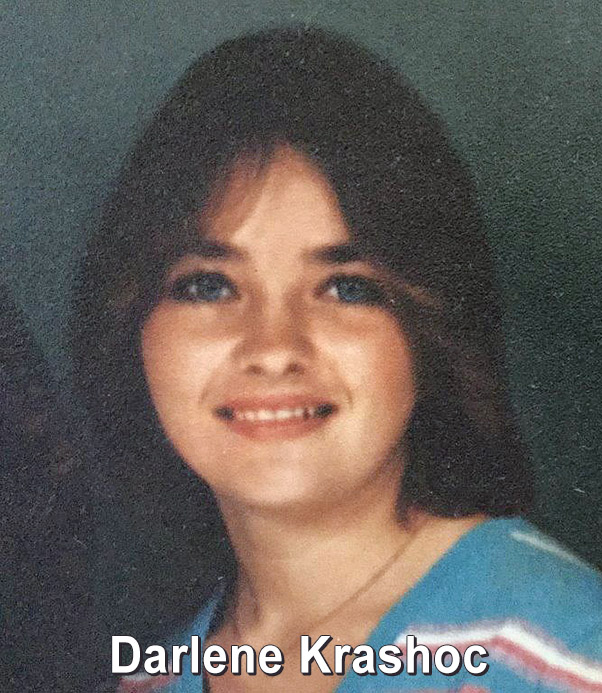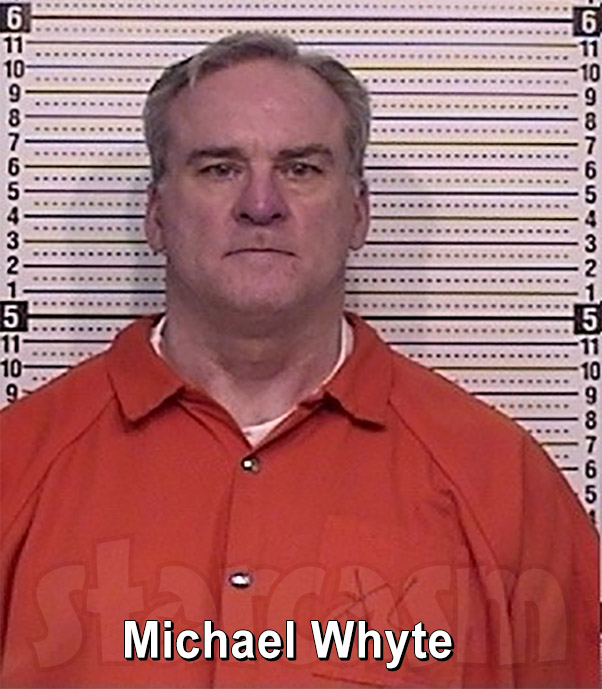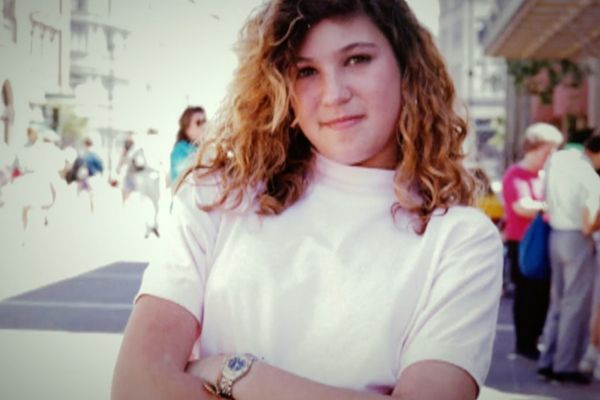HOMICIDE HUNTER Darlene Krashoc’s killer found 32 years later, Joe Kenda testified at the trial
“The most important part of homicide investigations is to never, ever give up,” former police detective Joe Kenda says as part of the lead-in to the Investigation Discovery special, Homicide Hunter: Never Give Up. There may be no better example among Kenda’s 387 cases than the rape and murder of 20-year-old G.I. Darlene Krashoc — a case that saw a conviction and life sentence 32 years later.
Thanks to a combination of thorough detective work, meticulous evidence collection and retention, modern DNA technology, and a technique known as genetic genealogy, police were able to identify Michael Whyte as a potential suspect in the 1987 cold case. Whyte was 24 years old at the time of the murder, and he was stationed at nearby Fort Carson.
58-year-old Whyte still lived in the Colorado Springs area in 2019, and police were able to follow him to a local fast food restaurant and retrieve his used cup from a trash bin. The DNA on the cup’s rim matched DNA from evidence gathered at the murder scene, including multiple cigarettes and the coat hanger that was twisted around Krashoc’s mouth and neck.
Whyte was arrested on June 13, 2019 and charged with first-degree murder. During his trial, Joe Kenda was called to testify — and he did so for roughly 75 minutes. As part of his testimony, Kenda reveals that he had a medical emergency roughly six days into the investigation. He says he was allowed to return to work after “weeks of recovery from the medical people.”
Prosecutors were able to make their case and Michael Whyte was found guilty of first-degree murder on June 24 of last year. A day after the verdict was read, Whyte was sentenced to life in prison without the possibility of parole.
“I didn’t kill Darlene Krashoc. Nothing else,” Whyte said when given the opportunity to address the court.
After Michael Whyte’s sentencing, the United States Army Criminal Investigation Command issued a press release recapping the 32-year Darlene Krashoc murder investigation and the resulting conviction of Michael Whyte. the release is included in its entirety below.
You can find out more about the investigation and conviction by watching Homicide Hunter: Never Give Up on Investigation Discovery or streaming on Discovery+
United States Army Criminal Investigation Command Press Release
1987 Army CID Cold Case Solved, Suspect Convicted
QUANTICO, VA (July 12, 2021) – More than three decades after the body of a female Fort Carson Soldier was found, justice has finally been served.
On June 25, a Colorado Springs jury sentenced Michael Whyte to life in prison without parole for the 1987 murder of 20-year-old Army Spc. Darlene Krashoc. Solved in 2019, the conviction comes two years after investigators from the U.S. Army Criminal Investigation Command connected Whyte to the murder using DNA evidence.
“It feels satisfying to know that the hard work and collaboration among multiple agencies in the pursuit of justice finally led to a successful resolution,” said CID Forensic Science Officer Jessica Veltri. “One that I hope brings some measure of peace to Darlene’s family and friends.”
On March 17, 1987, officers from the Colorado Springs Police Department (CSPD) found Krashoc’s body behind the Korean Club Restaurant in Colorado Springs, Colo. She had been last seen out with fellow members of her unit at another club in the local area. At the time of her death, Krashoc was an active-duty Soldier stationed at Fort Carson, Colo., assigned to the 73rd Maintenance Company and was five months shy of her 21st birthday.
An autopsy determined Krashoc’s death was due to strangulation. Investigators concluded she was brutally murdered at a different location and later the killer moved her body postmortem to the Korean Club Restaurant.
Over the years, special agents from Army CID worked jointly with the CSPD to solve the case. Despite all the interviews and evidence collected during the crime scene examination, the case went cold. In October 2003, the investigation was reopened to examine more evidence. Colorado Springs released all the evidence to the U.S. Army Criminal Investigation Laboratory (USACIL) and examiners there, processed the evidence using updated technology to search for clues.
“In this particular cold case, Special Agents from the U.S. Army Criminal Investigation Command used Phenotyping technology and put out a reward to generate new leads,” said Chris Grey, CID public affairs officer. “That led to the U.S. Army Criminal Investigation Command’s Criminal Investigation Laboratory assisting our Special Agent with the genealogy process, conducting additional forensic comparisons…”
In September 2014, Veltri was assigned the cold case while stationed at the 22nd Military Police Battalion (CID) at Joint Base Lewis-McChord, Washington. She was a recent graduate of the George Washington University Forensic Science Program in Washington, D.C.
David Zeliff, CID’s chief forensic science officer (FSO), said Veltri was very interested in working cold cases and eager to put her knowledge to good use.
“If an FSO that is headed out to a battalion has an interest in working on a cold case, I try to provide them one within the battalion footprint to work on while they are assigned there,” said Zeliff.
In May 2016, after a thorough review of the case, Veltri submitted 27 pieces of evidence to the U.S. Army Criminal Investigation Laboratory in Georgia for DNA forensic testing previously not available. This was a collective effort with the Colorado Springs Police Department to identify additional potential leads. The testing included re-analysis of previously submitted items and evaluation for Phenotyping, which Veltri had learned about while researching violent crimes.
Jennifer Coslin, now a supervisory Biologist, DNA Branch, USACIL, worked the DNA evidence provided by Veltri.
“I was very impressed with SA Veltri and her initiative to use the latest technology on this case,” said Coslin, recalling when she first started working with Veltri on the case. “Investigative genetic genealogy is a rather new tool and it was able to help us breathe new life into this investigation.”
In December 2016, CID sought the services of Parabon Nano Labs, a DNA technology company specializing in DNA phenotyping; the process of predicting physical appearance and ancestry from unidentified DNA evidence. This relatively new technology had never been used by CID and gave a more descript analysis of a possible suspect.
Using available DNA evidence from the investigation, the analysis produced trait predictions for the suspect in January 2017. Individual predictions were made for the suspect’s ancestry, eye color, hair color, skin color, freckling, and face shape. By combining these attributes of appearance, a “Snapshot” composite was produced depicting what the suspect may have looked like at the age of 20-25 years old, as well as a composite picture depicting what the suspect may have looked like 30 years later.
In May 2019, CID received the genealogy information and a name from a hit in the database. “Through the maternal and paternal lines they were able to identify a suspect,” said Zeliff, recalling the news received during a teleconference with the genealogy research company.
“We received the investigative genetic genealogy report and there was only a single name listed in the report,” said Coslin, who had been working evidence from the case since 2005. “That was a pretty memorable moment … we were able to put a name to the unknown profile. I wasn’t sure if we would ever get to this point.”
The name was used to compare against military records and it was determined the DNA profile belonged to retired Sgt. First Class Michael Whyte who was stationed at Fort Carson at the time Krashoc was murdered.
Veltri recalls being both excited and in disbelief after they “finally found him.”
“Receiving the results of the genetic genealogy report and hearing how the analyst worked through publicly sourced data to identify a specific name was incredibly exciting,” she said. “We finally had a viable lead that could potentially confirm Michael Whyte was the killer.”
Chief Warrant Officer Five Joel Fitz, command chief warrant officer for CID, said the information was shared with CSPD who then conducted a surveillance operation on Whyte. The suspect still lived in the same general area where the murder occurred years ago. During the operation, a cup was collected as evidence at a fast food restaurant that Whyte had used and then disposed of in a trash can. The DNA from the cup came back as a positive match to the DNA found at the crime scene.
“I’m so happy they kept the DNA after all these years,” Rhonda Lilly, Darlene’s sister, told Army Times in 2019. “The Colorado Springs PD and Army CID never forgot about her.”
On June 12, 2019, an arrest warrant was obtained and the following day members of the Violent Offender Fugitive Task Force, CSPD Cold Case Homicide Unit, and U.S. Army CID, arrested Whyte at his residence.
“As a DNA Examiner, my role is to work the evidence and report on the findings” said Coslin. “While every case that we work in the laboratory is important, cold cases bring unique challenges and rewards. I am so pleased that this case has been solved.”
Coslin said she is “proud of the work” USACIL does every day and happy to be a part of the CID team.
“Through the dedication of professional effort and extra time that Special Agent Veltri was willing to dedicate to this case, we were able to ultimately get a solution of the case and in some way some small amount of closure for the family in this case,” said Zeliff.
Veltri said both the Army’s crime lab and Coslin were “huge factors” in this case being solved.
“The success of this case was dependent on several factors,” said Veltri. “A thorough and professional initial investigation and crime scene processing by the original police sergeants, detectives and CID agents who worked the case in the late 1980s; the positive working relationship between the Colorado Springs Police Department and Army CID that spanned the entire investigation; the incredible professionalism and dedication of our crime laboratory partners and the open-mindedness of CID leaders to treat this case differently in order to solve it.”
New forensic science technology available to Special Agents and USACIL continues to transform the way CID solves complex felony investigations.
Asa Hawks is a writer and editor for Starcasm. You can contact Asa via Twitter, Facebook, or email at starcasmtips(at)yahoo.com









